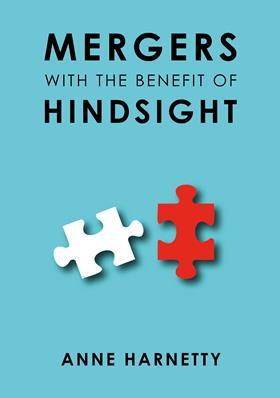Mergers with the Benefit of Hindsight
Anne Harnetty
£14.99, Brown Dog Books
★★★★✩
It is often said that many things would have been better with the benefit of hindsight. Anne Harnetty’s book will hopefully prove that saying true, and assist firms embarking on a merger and acquisition strategy.
The great attraction of this book is that it provides insight through quotes from managing partners, senior partners, CEOs and COOs who have been fully involved in a merger and acquisition journey between 2012 and 2020. Therefore, it is what they have learnt and what they may have done differently that has such value. These experiences from over 50 mergers are wrapped around chapters from other experts in the legal sector who have penned five of them.
It has been said for several years that the legal sector is due a merger and acquisition boom. Whether that will come from consolidators or more traditional marriages of firms remains to be seen.
Harnetty discusses the reasons for mergers. A firm might decide that the only way to avoid a painful professional indemnity run-off insurance payment is to find a merger partner, or a merger might be a neat geographical fit, or a merger might enhance services for an existing client base.

This process should never be one that is left until the last minute but one that is part of a firm’s long-term strategy. This should not be seen as weakness – surely the aim for any business is the continuation of service to clients.
With an increasingly challenging recruitment arena, this brings firms’ succession issues into sharper focus. One reason why it is beneficial for partners to identify talent and future successors at an early stage, is to hopefully facilitate their own smooth transition into retirement. Where this has not been achieved, there is thus another reason why the sector is so merger and acquisition hungry.
Recent deals I have been involved with generated goodwill payments, so do not believe that this is not possible. But you should not operate in a deluded state that your firm, which has barely covered your own moderate drawings, will be something that someone else values highly, or at all. Valuations at present do need to consider recent Covid spikes, especially in respect of conveyancing.
While it is recommended that you keep all your advisers in the loop, and it is best to get all the issues out of the way early, one contributor rightly or perhaps bluntly suggests that ‘a pig wearing lipstick is still a pig’. This statement emphasises the point that a merger should never be a vanity project for either side, or for a dominant partner in a firm. For a transaction to succeed, a business case should be made, which is understood by all involved. There should be a well-thought-out strategy, and a project team (internal and external) which can sustain both momentum and a collaborative approach on both sides to create something that is bigger than the sum of the parts.
The book also discusses what can stop integration once a merger has been completed. There are many reasons why a ‘them-and-us’ attitude can remain. Culture, communications, behaviour of partners and staff, along with overlooked client considerations, can all come into play.
Harnetty also considers marketing and IT to enable you to plan and focus that successful integration.
The final chapter, ‘What did we learn’, highlights key points from research. A few commonsense strategies to keep in mind, during and after the merger process, are considered. This is a useful final checklist in order to benefit from hindsight.
Peter Noyce is a partner at Menzies LLP, Woking. He wrote one of the chapters in Mergers with the Benefit of Hindsight





























No comments yet